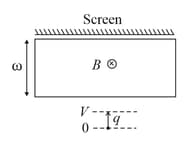In a region of space, both electric and magnetic field are present simultaneously in opposite directions. A positively charged particle is projected with certain speed an angle with magnetic field. It will move in a
Important Questions on Moving Charges and Magnetism
| Column 1 | Column 2 | Column 3 |
| 1. Electron with | (i) | (P) |
| 2. Electron with | (ii) | (Q) |
| 3.Proton with | (iii) | (R) |
| 4. Proton with | (iv) | (S) |
In which case would the particle move in a straight line along the negative direction of y axis
| Column 1 | Column 2 | Column 3 |
| 1. Electron with | (i) | (P) |
| 2. Electron with | (ii) | (Q) |
| 3.Proton with | (iii) | (R) |
| 4. Proton with | (iv) | (S) |
In which case will the particle describe a helical path with axis along positive z direction?
| Column 1 | Column 2 | Column 3 |
| 1. Electron with | (i) | (P) |
| 2. Electron with | (ii) | (Q) |
| 3.Proton with | (iii) | (R) |
| 4. Proton with | (iv) | (S) |
A rectangular region of dimensions has a constant magnetic field into the plane of the paper as shown. On one side the region is bounded by a screen. On the other side positive ions of mass and charge are accelerated from rest and towards the screen by a parallel plate capacitor at constant potential difference , and come out through a small hole in the upper plate. Which one of the following statements is correct regarding the charge on the ions that hit the screen?


